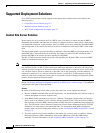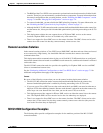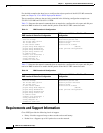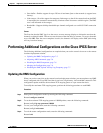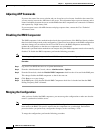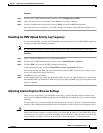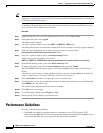
CHAPTER
7-1
SRND for Cisco IPICS Release 2.0(1)
OL-12456-01
7
High Latency and Low Bandwidth
Interconnection
Cisco IPICS provides support for environments that include high latency and low or variable bandwidth
links, such as satellite links. In these types of environments, connectivity may become unstable because
of the geographical location of the user, weather elements, and other interferences. In this release, Cisco
IPICS compensates for these dynamically variable bandwidth scenarios and enhances its support for
mobile operations.
Cisco IPICS supports the following deployment scenarios:
• Central site server solution—Supports a Cisco IPICS server that is installed at a central site and a
distributed router media service (RMS) and end-user client components that are installed at a remote
site.
• Remote locations solution—Supports deployment of the Cisco IPICS server, RMS, and end-user
clients at two remote sites that are connected by M1:U12:M2 tunnels.
• Remote PMC solution—Supports a Cisco IPICS server and a distributed RMS at a central site and
end-user PMC clients at a remote site.
Note Note: With this deployment scenario, remote PMC clients must be configured to use the
“Optimize for low bandwidth” setting in the PMC Settings > Channels menu. For information
about how to configure the PMC for use in this deployment scenario, refer to the “Configuring
the PMC Application” chapter in Cisco IPICS PMC Installation and User Guide, Release 2.0(1).
The M1:U12:M2 tunneling technology enables these deployment scenarios. For more information about
these deployment scenarios, see the “Supported Deployment Solutions” section on page 7-2.
This chapter includes these topics:
• Supported Deployment Solutions, page 7-2
• Requirements and Support Information, page 7-4
• Performing Additional Configurations on the Cisco IPICS Server, page 7-5
• Performance Guidelines, page 7-8




